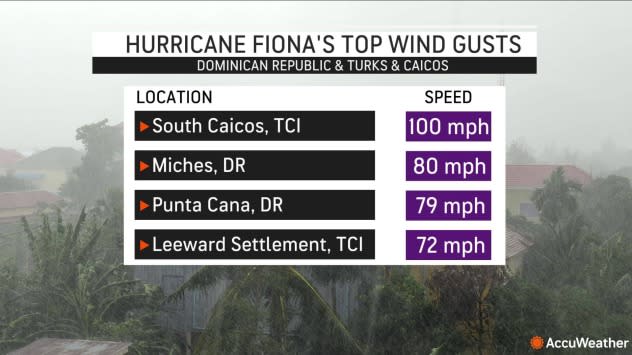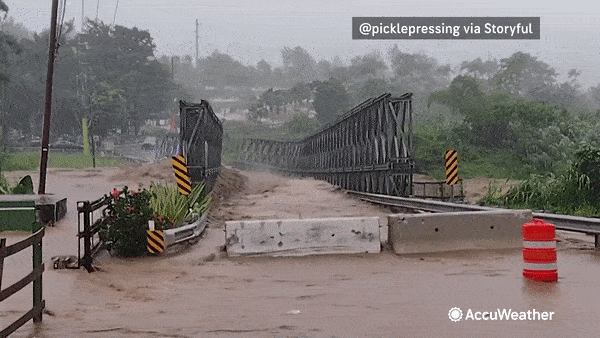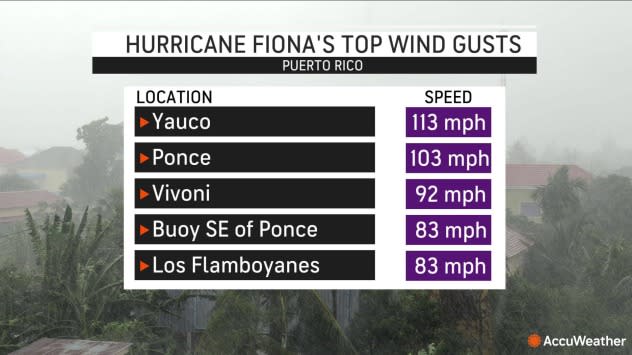Power slowly being restored in Puerto Rico, but severe flooding remains
The power outage situation in Puerto Rico remained dire for a fourth day on Wednesday due to the impacts from Hurricane Fiona, which moved away from the Turks and Caicos after pummeling the islands on Tuesday as a Category 3 storm. By Wednesday morning, Fiona was headed northward and had strengthened to a Category 4 hurricane, packing 130-mph sustained winds.
Sheets of rain whipped through the islands blown by maximum sustained winds of 115 mph on Tuesday at the height of the storm in the Turks and Caicos. Local authorities advised all residents and tourists to remain indoors and refrain from travel, as the potential for major damage loomed for local trees and weakly-structured buildings.
Video captured from the Coral Gardens Resort in Providenciales showed trees struggling to stay upright amid the heavy winds as the skies were completely greyed out by the storm.
Fiona did the same over the weekend and into Monday across Puerto Rico and the Dominican Republic as torrential rain led to flooding, and powerful winds resulted in major power outages. In Puerto Rico, more than 48 hours after Fiona's landfall, over 1.1 million customers were still without power according to PowerOutage.US, which added that "updates, exact numbers, and restoration timelines are not available."
 |
Officials blamed at least five fatalities in the northern Caribbean on the storm. As Fiona strengthened into a Category 3 storm late Monday night, conditions began to worsen across the Turks and Caicos Islands.
Power was slowly being restored to some parts of the island, but as of Wednesday, nearly 1.1 million customers, or roughly 74% of the island, remained without electricity. That was down slightly from the day before, when 80% of Puerto Rico had no power. The lengthy power outage problem is one of the reasons AccuWeather is estimating the economic impact on the island from Fiona to be about $10 billion.
LUMA, the private energy company that controls electricity for the entire island and which has come under heavy criticism, said Wednesday that it had crews out working to get the power back on throughout the island. In a statement posted on Twitter, the company said, it "will not rest until all clients have electricity service and the electrical network is reenergized."
Meanwhile, aerial footage shot on Tuesday by the U.S Coast Guard showed that widespread flooding was still a major problem across Puerto Rico, days after Fiona's landfall.
A 70-year-old man was killed in Puerto Rico when he tried to fill a generator with gasoline while it was running, setting it on fire, the AP reported. A 58-year-old man died when he was swept away by an overflowing La Plata River behind his home in Comerio, Puerto Rico, a spokesperson for Gov. Pedro Pierluisi told CNN.
Officials told local media that Isidro Quiñones, a 60-year-old man died in the Dominican Republic when a tree fell on him. A second death in the Dominican Republic was confirmed by officials Tuesday, as 18-year-old Aurielys Esther Jimenez was struck by a power pole while riding her motorcycle, with the pole falling from strong winds. Jimenez was pronounced dead after being taken to a hospital.
According to a report from Reuters, before Fiona made landfall in Puerto Rico, one person died in the French Caribbean archipelago of Guadeloupe, which is a part of the Leeward Islands.
Hurricane Fiona made landfall as a Category 1 storm at 3:20 p.m. EDT Sunday, Sept. 18, on the extreme southwestern coast of Puerto Rico, near Punta Tocon. Roughly 12 hours later, Fiona made landfall at a similar intensity near Punta Cana, on the eastern coast of the Dominican Republic.
Fiona was the first hurricane to make a direct hit on the Dominican Republic since Hurricane Jeanne left sustainable damage in Sept. 2004. Fiona forced 12,500 people from their homes and left 709,000 without power, Reuters reported. Emergency workers on the Dominican Republic rescued nearly 800 people amidst the storm, officials reported.
"The damage is considerable," the Dominican Republic President Luis Abinader said, Reuters reported.
In Puerto Rico, the damage from Fiona was hard to miss. Roads were stripped of pavement, roofs were torn off houses, a bridge was completely washed away and millions were left without drinking water.
Officials in Puerto Rico stated that 670 people have been rescued on the island during the chaos.
 |
Surging floodwaters from Hurricane Fiona ripped away this bridge over the Guaonica River in Utuado, Puerto Rico. The bridge was installed after Hurricane Maria in 2017. |
Manuel Crespo, a news reporter and weather anchor for TeleOnce, was on the scene in southwestern Puerto Rico Monday morning and noted that torrential rain and wind were still pounding the area as authorities rescued people who were left stranded in their homes following flooding.
Crespo told AccuWeather that the flooding from Fiona was "worse than people thought [it would be]," adding that people he spoke with were not prepared for this amount of rain.
"Some people are comparing this to Hurricane Maria. Some say it is worse than Hurricane Maria," Crespo said.
 |
Hurricane Fiona's landfall coincides with the 5-year mark since Hurricane Maria, a devastating Category 4 storm that destroyed the island's power grid and left nearly 3,000 people dead. Infrastructure remains weak, and many homes still have blue tarps as a roof, which worsened the impacts from Fiona.
"Hurricane Fiona will have a major negative impact on the economy of Puerto Rico," said AccuWeather Founder and CEO Dr. Joel N. Myers, who projected that the fallout from the storm will be about $10 billion in Puerto Rico alone.
"Since Sunday afternoon there has been a major failure of the electrical grid resulting in an outage of power to the entire island impacting more than 1.4 million customers, or 3.2 million people, and only 100,000 customers, less than 10 percent, apparently have restored power currently," Myers said Monday evening, explaining how he arrived at the figure. "In addition, water service is not available to over 750,000 customers or more than 2 million people."
 |
Homes are flooded on Salinas Beach after the passing of Hurricane Fiona in Salinas, Puerto Rico, Monday, Sept. 19, 2022. (AP Photo/Alejandro Granadillo) |
To put AccuWeather's estimate for the total economic loss from Fiona into perspective, Hurricane Maria caused $90 billion in damages, according to AccuWeather and later NOAA estimates. The lingering effects of Fiona in Puerto Rico will be brutal, Myers suggested.
"The GDP of Puerto Rico is about $103 billion per year," said Myers. "An economic impact of around $10 billion is slightly less than 10 percent of the GDP, but, significantly, it is equivalent to a severe recession."
Myers also pointed out that the capital and largest city, San Juan, has fortunately largely avoided the worst of the flooding and wind damage.
By Monday evening, multiple rain gauges across Puerto Rico had surpassed the 2-foot mark and at least one location had eclipsed the 30-inch mark. On the southern coast of Puerto Rico, a gauge near Ponce measured 31.34 inches of rain as of Monday afternoon. Just nearby in La Plaza, 27.12 inches of rain was reported.
According to the United States Geologic Survey (USGS), the Rio Guanajibo River near Hormigueros, in southwestern Puerto Rico, crested at 29.2 feet Monday morning, exceeding its previous record mark of 28.6 feet set during Hurricane Maria in 2017.
 |
On Sunday, the Rio Grande De Manati River near Ciales, situated in north-central Puerto Rico, rose over 15 feet in just three hours, and as much as 1.26 feet in three minutes.
That would equate to a water level rise of an inch every 12 seconds and would have been fast enough for people to witness the floodwaters surging," AccuWeather Senior Weather Editor and meteorologist Jesse Ferrell said, adding that this underscores the dangers of flash flooding and explains how sometimes there is not enough time to evacuate once the waters have started to rise.
Prior to Fiona's landfall, President Joe Biden declared a state of emergency in the U.S. territory Sunday morning. The action authorizes the Federal Emergency Management Agency (FEMA) to coordinate disaster relief efforts on the island.
Deanne Criswell, the administrator of the Federal Emergency Management Agency (FEMA), traveled to Puerto Rico Tuesday to meet with Governor Pierluisi and assess damages caused by Fiona. Keith Turi, Assistant Administrator of the FEMA Recovery Directorate, provided an update Tuesday and stated that FEMA will be sending hundreds of additional staff to the island over the next several days, and that around 700 employees are already on the ground supporting recovery.
Turi noted that the focus for those already in Puerto Rico is conducting power restoration assessments, including connection to water and pumping stations.
As Hurricane Fiona moved away from the northern Caribbean Monday evening, it intensified into the first major hurricane, which is considered a Category 3 or higher on the Saffir-Simpson Hurricane Wind Scale, of the 2022 Atlantic hurricane season. AccuWeather forecasters warn that Fiona could strengthen into a Category 4 as it comes perilously close to Bermuda later this week. Rough surf is expected to be felt up and down the U.S. East Coast.
Want next-level safety, ad-free? Unlock advanced, hyperlocal severe weather alerts when you subscribe to Premium+ on the AccuWeather app.AccuWeather Alerts™ are prompted by our expert meteorologists who monitor and analyze dangerous weather risks 24/7 to keep you and your family safer.






